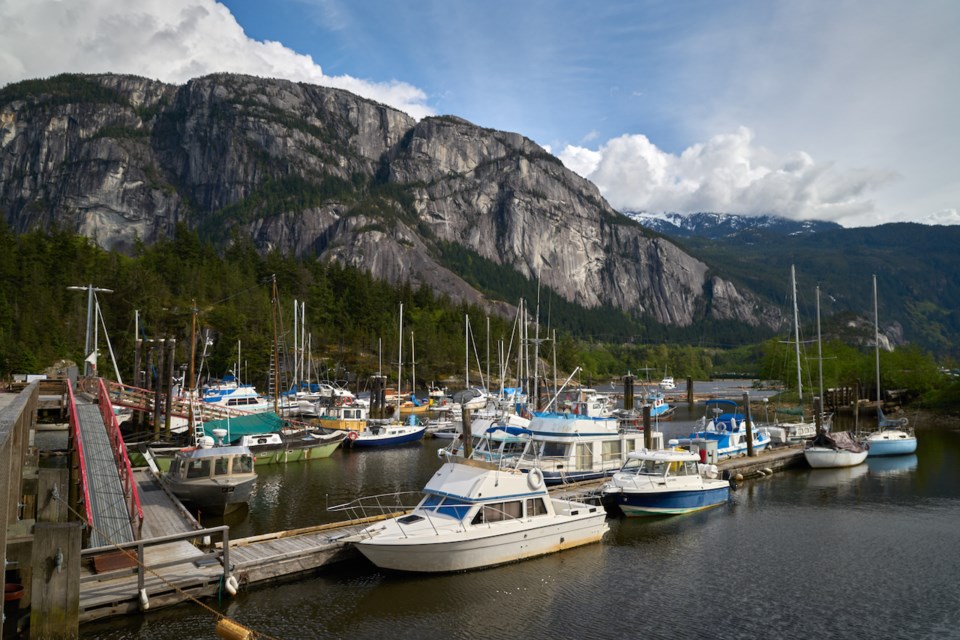The District of Squamish has begun the first significant step toward formalizing its governance over the town's waters with a marine zoning overhaul.
On March 16, council voted 6-1 in favour of granting first reading to a bylaw that would create a set of new marine zones in the community. Coun. Chris Pettingill was the sole dissenting vote.
Coun. Doug Race said the bylaw, which has been a long time coming, impacts the many people who use and pass through the town's waters.
"This represents a lot of work; there's a lot of different levels to marine zoning that may not be apparent of zoning on the land," said Race.
"I think this is a really good thing. There might be the odd little tune-up coming along based on comments, but, this, I think, is a great first step."
The main highlights are the five new zones for the town's waters.
The first is the M1 Marine Navigation zone, which allows for general travel through the water. Community water access and public boat launches are allowed in the zone, which is intended to cover the navigation channel in the Mamquam Blind Channel, undeveloped foreshores, and the outlying marine coastal area.
An M2 Marine Mixed Use designation is the next proposed zone for the town's waters.
These areas will accommodate commercial and recreational uses. It's also intended to be an area where marina infrastructure, moorage and marine retail are allowed.
Some examples of permitted uses include fuel sales, boat rentals and charters, restaurants, community uses and outdoor recreation stages.
Fuel sales turned out to be the main point of contention during council's debate.
Pettingill insisted the bylaw should ensure renewable energy — like electric chargers — is required for all marine refuelling stations, while fossil fuel would be optional.
Most of the other members of council disagreed, saying it would be too impractical.
Coun. Race, who is a boater himself, said electric boats are not a regularity on the water. Furthermore, requiring electric chargers would likely result in no refueling station being built there at all — or at least not for a very long time.
Pettingill countered that the technology was catching up, and declined to support first reading when council did not move to accommodate his suggestion for mandatory renewable energy.
"Something like this is really important, and, so, I think in everything that comes forward, we have to be pushing and leading on this, and I don't think we're doing that there, and I believe that's critical as we're rebuilding our new transportation infrastructure," said Pettingill, citing the climate emergency.
This zoning is expected to include marina-type areas on the west side of the Mamquam Blind Channel, the Oceanfront development area, and the area around the SEAandSKY Waterfront landing development.
It also has implications for many people who live aboard their vessels.
Under this zone's rules, a maximum of 10 people may live aboard their boats under the condition they use a pump-out connection for land-based sewage disposal. The pump-out facility should be within 150 metres of any liveaboard vessel.
Coun. Eric Andersen wondered how the use of sewage disposal facilities could be practically enforced.
District planner Sarah McJannet said marinas have generally been looking after their own affairs, but including this condition in the zoning will allow the municipality to get involved if needed.
McJannet said the municipality doesn't have the enforcement capacity to inspect every boat, but noted the District would be working with marinas.
While the 10-person maximum is stipulated in the zoning, the staff report notes that individual marinas may lower that limit at their discretion.
Squamish has one pump-out facility located at the Squamish small craft harbour, which is now open for unrestricted use 24-7, and marinas will be expected to ensure sewage is disposed of properly.
The next proposed zone is dubbed the M3 Marine Recreation zone, and it's associated with
community docks, floats and piers, public boat launch or ramp, a boatshed, a marine park, and tourism, among other things.
This zone is expected to be implemented on the water lot fronting Xwu'nekw Park, which is on the west side of Mamquam Blind Channel.
A designated zone for logging-related activity will also be created.
The M4 Marine Log Storage zone is expected to surround Site B on the east side of the Mamquam Blind Channel. It also allows for limited water-based log handling.
Andersen commended staff for the work and engagement with the community, but added there were still items on his wish list down the road.
He said Zoning for Site B and Squamish Terminals have not been specifically zoned for marine uses only. Currently, they are industrial zones, he said.
"Perhaps... we should consider a specific marine zoning for these areas," Andersen said.
As an example, Andersen said the province designated the terminal for port use only, not general industrial use.
In addition to the current proposals, he said more work should eventually be done on the Marine Action Strategy.
Finally, an M5 Marine Transportation Facilities zone is expected for the Darrell Bay Ferry Terminal.
This will be a spot-zone for the area covered by a provincial order that has reserved the site for use as a ferry terminal.
Pettingill asked that staff look into examining the language to ensure a public ferry service can still be used in the area if a private company sets up a ferry service at the site.
Woodfibre LNG has proposed using the site to ferry its workers to its plant.


